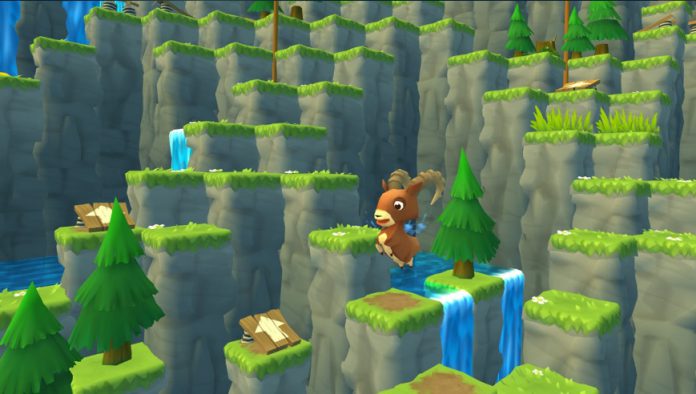Zynga making an entry into the world of virtual reality (VR) should come as no surprise, neither should the fact that it’s with a free-to-play videogame with some interesting monetisation techniques. However, that Mountain Goat Mountain is such a competent adaptation of a smartphone videogame is commendable: it’s most certainly fun, if only for a short while.
Taking its cues from Q*Bert, Mountain Goat Mountain sees the player in direct control of a mountain goat as it tries to ascend a cube-based mountain. Various hazards and traps exist along the way, including falling logs and rocks, trees that block your path, crumbling stone steps and lightning clouds. However there are also numerous power-ups – armour and high jump boosts – as well as spring boards that can either hasten your ascent or leave you in near-immediate peril. Planning your movements two jumps ahead is vital for success in Mountain Goat Mountain.
That success is determined by a high score. The move cubes you traverse upwards, the higher your score. There’s little else to Mountain Goat Mountain aside from this. There’s no intro sequence, no story, no cutscenes or asides. Mountain Goat Mountain is simply a videogame made for the sake of direct, impartial entertainment.
A concern for the peculiarly muted launch of Mountain Goat Mountain was the introduction of in-game advertising into the world of modern VR. However, it’s been handled quite well (or deliberately, depending on your degree of cynicism). Mountain Goat Mountain offers different goat avatars available for purchase with in-game currency collected on each level and once a day through a daily reward.

Occasional bonus levels will pop-up, offering the player the chance to grab more coins with every jump, courtesy of a sponsor. However, it’s simply a logo and an optional level; there are no video interstitials, no aggressive product up-sells and no microtransactions anywhere else in the videogame. Subtle and unobtrusive then, and given the fact that videogames cost money to produce there’s an argument for an audience who wouldn’t spend money on Mountain Goat Mountain, but will enjoy it for a short while due to trying it simply because it’s free.
The biggest issue with Mountain Goat Mountain on Oculus Rift is that you have to wonder exactly what VR brings to the videogame. A non-VR version developed for consoles and played on a traditional 2D screen would offer a very close facsimile of the gameplay and its depth (or lack thereof). Mountain Goat Mountain is short-lived fun that’s hardly pushing your expensive VR set-up to the limits, but neither is it as offensive to the existing VR audience as it could easily have been.















